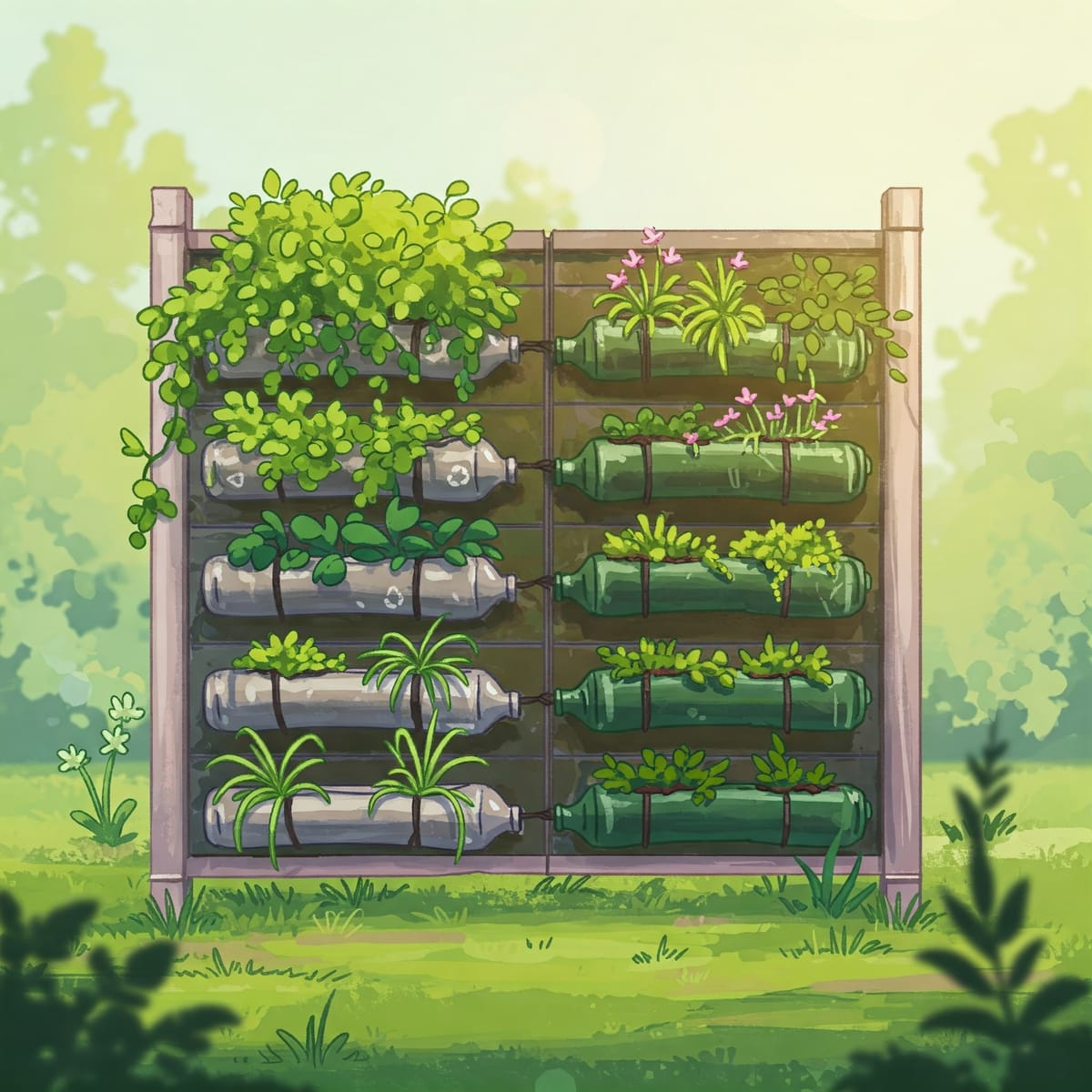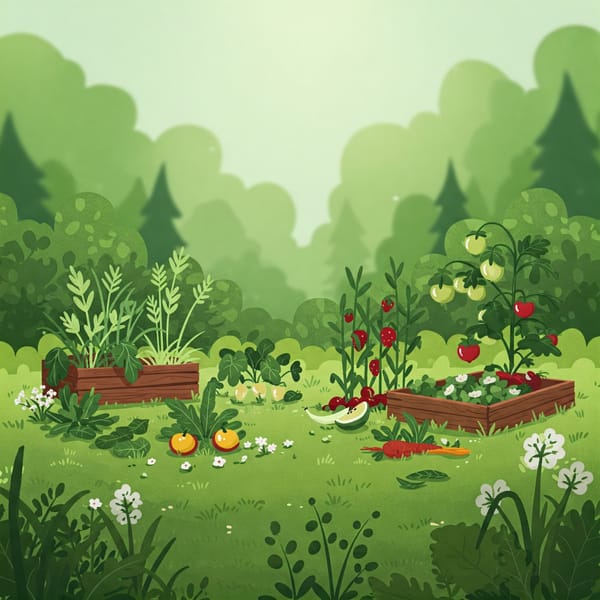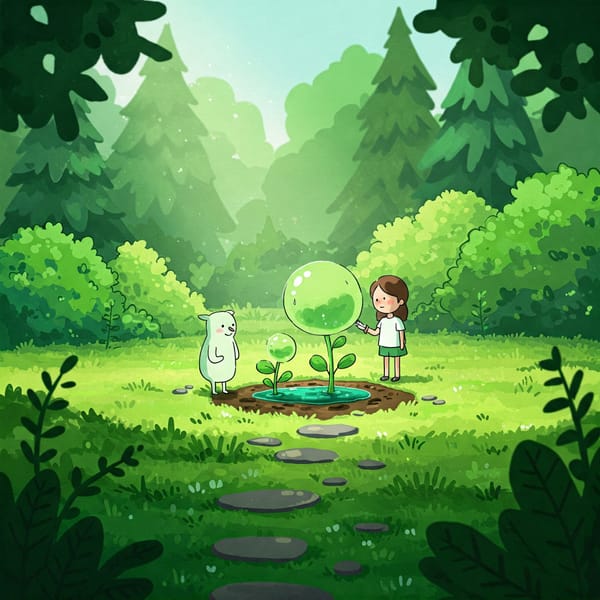DIY Vertical Gardens from Recycled Materials: A Sustainable Gardening Solution

TLDR
This blog post explores the concept of upcycled vertical gardens, where discarded materials are repurposed into functional gardening structures. It discusses the environmental benefits, suitable materials, design and construction techniques, plant selection and care, community initiatives, and safety considerations. The goal is to empower individuals and communities to embrace this sustainable and enriching practice.
DIY Vertical Gardens from Recycled Materials: A Sustainable Gardening Solution
Introduction: The Rise of Upcycled Vertical Gardens
In an increasingly urbanized world, the desire to connect with nature and cultivate green spaces often encounters the constraint of limited area. Vertical gardening has emerged as an innovative solution, allowing individuals to grow plants upwards rather than outwards, maximizing space utilization, particularly in densely populated urban environments. This method not only addresses spatial limitations but also aligns with a growing interest in sustainable practices. Complementing this trend is the rising popularity of Do-It-Yourself (DIY) approaches to gardening, fueled by a desire for creative expression and a heightened awareness of environmental concerns. At the intersection of these trends lies the concept of upcycled vertical gardens, where discarded materials are repurposed and transformed into functional and aesthetically pleasing gardening structures. Upcycling, in this context, refers to the creative reuse of waste materials to create something of higher value or quality. This blog post aims to provide an in-depth guide to the creation of DIY vertical gardens using recycled materials. It will explore the environmental advantages of this approach, identify a wide range of suitable materials, detail design and construction techniques, discuss plant selection and care, examine community initiatives, and address essential safety and practical considerations. Ultimately, this blog post seeks to empower individuals and communities to embrace upcycled vertical gardening as a sustainable and enriching practice.
Sustainability at the Core: Environmental Advantages of Recycled Materials
The adoption of recycled materials in the creation of vertical gardens offers significant environmental benefits compared to the use of new, commercially produced gardening supplies. By giving discarded items a new purpose, gardeners actively contribute to waste reduction. Repurposing materials like plastic bottles, tin cans, and wooden pallets diverts them from landfills, thereby alleviating the strain on waste management systems and minimizing the generation of methane, a potent greenhouse gas. This simple act helps extend the lifecycle of materials and reduces the overall volume of waste destined for disposal.
Furthermore, utilizing recycled materials plays a crucial role in resource conservation. The production of new gardening supplies often necessitates the extraction of virgin resources such as timber, minerals, and water, leading to habitat destruction and deforestation. By opting for recycled alternatives, gardeners lessen the demand for these raw materials, contributing to the preservation of natural ecosystems. Moreover, the manufacturing of new materials is typically an energy-intensive process that results in substantial carbon emissions. In contrast, using recycled materials generally requires less energy, thus lowering the carbon footprint associated with gardening practices. This shift towards upcycling helps mitigate climate change by reducing greenhouse gas emissions.
Beyond the environmental advantages, upcycling can also lead to significant cost savings for gardeners, as it reduces the need to purchase new containers and structures. This makes gardening more accessible and affordable for individuals and communities. Finally, the practice of repurposing waste materials supports the principles of a circular economy, where resources are kept in use for as long as possible, reducing waste and minimizing the need for new production. The increasing awareness of environmental issues has undoubtedly contributed to the growing popularity of sustainable gardening practices like upcycling. As individuals become more conscious of their environmental impact, they actively seek eco-friendly alternatives in various aspects of their lives, and gardening provides a tangible and rewarding avenue for making sustainable choices. The widespread adoption of upcycled gardening practices has the potential to generate substantial environmental benefits at a broader societal level. When numerous individuals engage in such sustainable actions, the cumulative effect can lead to measurable reductions in waste, resource consumption, and carbon emissions, contributing to a more environmentally responsible future.
From Waste to Resource: Identifying and Preparing Recycled Materials
The beauty of DIY vertical gardens using recycled materials lies in the vast array of readily available items that can be transformed into thriving plant habitats. These materials can be broadly categorized into household treasures and industrial finds.
Household Treasures
Many items commonly found around the home can be given a new lease on life as components of a vertical garden. Plastic bottles, for example, are incredibly versatile and can be used to create individual hanging planters, self-watering systems, or even stacked vertical gardens. Their lightweight nature and ease of modification make them ideal for various designs. Similarly, tin cans are well-suited for housing small plants and herbs and can be easily painted and decorated to enhance their aesthetic appeal. Fabric scraps, often leftover from sewing projects, can be creatively utilized to fashion hanging pockets or fabric wall planters, adding a soft and textured element to vertical garden displays. Glass bottles and jars can also be repurposed as unique planters, or glass bottles can be inverted and used as decorative garden edgers or to create simple self-watering systems. Milk jugs, with their convenient handles, can be transformed into practical watering cans or used to protect vulnerable seedlings from late frosts.
Even everyday items like newspapers and cardboard can play a role in a sustainable garden, serving as effective weed barriers, mulch to retain soil moisture, or even being fashioned into biodegradable seedling pots. For a more rustic aesthetic, old tires can be painted and stacked to create eye-catching and functional planters. Finally, even seemingly unusable items like old shoes and boots can be given a whimsical new purpose as quirky and unconventional planters. The sheer variety of common household items that can be upcycled into vertical garden components underscores the accessibility of this sustainable gardening method for nearly everyone. These readily available materials possess inherent structural qualities suitable for containing soil and supporting plant growth, making DIY vertical gardening with recycled materials a practical option for a wide range of individuals. Furthermore, each of these materials offers unique design possibilities and can be adapted to accommodate different scales and types of plants, allowing for creativity and personalization in garden design.
Industrial Finds
Beyond household waste, a variety of industrial byproducts can also be repurposed to create more substantial vertical garden structures. Wooden pallets, for instance, are sturdy and often readily available for free or at low cost from businesses. Their robust construction makes them ideal for creating large vertical garden structures and raised beds, capable of supporting a significant number of plants. Reclaimed wood, salvaged from old buildings or other structures, adds a touch of rustic charm to gardens and can be transformed into frames, raised beds, and other structural elements for vertical displays. Broken concrete and bricks, often leftover from construction or demolition projects, can be repurposed to create attractive borders, pathways, or as stable structural components within vertical gardens. Recycled plastic lumber, made from processed plastic waste, is a durable and moisture-resistant material suitable for building long-lasting outdoor vertical garden structures. Finally, various metal items, such as old screen doors with interesting designs or discarded aluminum kitchenware, can be creatively repurposed as unique trellises for climbing plants or as distinctive planters themselves. The utilization of industrial recycled materials like pallets allows for the creation of larger and more substantial vertical gardens, catering to individuals with more space or those seeking to grow a greater quantity and variety of plants. These materials, often designed for resilience in their original applications, possess inherent durability that makes them well-suited for long-lasting outdoor vertical garden structures, extending their useful life and reducing the need for frequent replacements.
Cleaning and Preparation Protocols
Before any recycled material can be used to house plants, proper cleaning and preparation are essential to ensure the health of the plants and the safety of the gardener. A general first step involves removing any loose soil, dust, debris, and old labels using a stiff brush, soapy water, or a pressure washer. For non-porous containers like plastic and glazed ceramic pots, disinfection can be achieved by soaking them in a solution of one part household bleach to nine parts water for at least 10 minutes or by wiping all surfaces with rubbing alcohol. Mineral deposits that often form on the inside of pots can be removed from plastic and ceramic with a scouring pad, while tougher deposits may require scraping with a knife; terracotta and clay pots may need scrubbing with steel wool or a wire brush.
The preparation of plastic bottles involves removing labels (soaking in warm water often helps), carefully cutting them to the desired shape for the chosen design, and creating drainage holes in the bottom to prevent waterlogging. Painting the inside of clear plastic bottles white can help protect plant roots from direct sunlight and excessive heat. Wooden pallets require careful inspection for chemical treatments, particularly avoiding those marked with "MB" which indicates treatment with methyl bromide, a toxic pesticide. Pallets marked "HT" signify heat treatment and are a safer option for gardening. Thorough cleaning with soap and water, a diluted bleach solution, or a vinegar solution is recommended to remove dirt and potential contaminants. Sanding down any rough spots or splinters is important for safety and can also help sealant adhere better. Applying a non-toxic wood sealant will protect the pallet from moisture and pests, prolonging its lifespan. Adding a landscape fabric liner to the back and sides of the pallet can help retain soil within the structure.
For tin cans, the preparation process includes washing them thoroughly to remove any remaining food residue and peeling off the labels. Vegetable oil can be helpful in removing stubborn glue residue. Drainage holes should be created in the bottom of the cans using a nail and hammer or a drill to allow excess water to escape. Sanding down any sharp edges, especially around the top rim where hands will be working, is crucial for safety. Sealing the inside of the cans with a non-toxic sealant can help prevent rust formation. Finally, the exterior of the tin cans can be painted or decorated according to the gardener's preferences. When using fabric scraps, it is advisable to wash them to remove any potential contaminants. The sturdiness of the fabric should be considered if it is intended to hold soil directly as part of a hanging pocket or wall planter.
Proper cleaning and preparation are fundamental for ensuring the safety of both the plants and the gardener, especially when dealing with recycled materials that may have previously contained chemicals or food substances. Different types of recycled materials necessitate specific preparation techniques to optimize them for use in gardening. For instance, plastic containers require drainage to prevent waterlogging, wood needs protection against rot and pests, and metal is susceptible to rust. Understanding the properties of each material informs the necessary preparation steps to create a functional and long-lasting vertical garden.
Designing Your Green Wall: DIY Vertical Garden Designs with Recycled Materials
The versatility of recycled materials allows for a wide range of creative and functional designs for DIY vertical gardens, catering to various space constraints, plant types, and aesthetic preferences.
Plastic Bottle Innovations
Plastic bottles offer numerous possibilities for vertical gardening. Hanging bottle gardens can be created by cutting rectangular or circular openings in the sides of the bottles to accommodate plants. Drainage holes should be made in the bottom of each bottle to allow excess water to escape. These bottles can then be hung individually or in decorative clusters using twine, wire, or zip ties from fences, walls, or suspended structures. For a stacked bottle tower design, the bottom is cut off some bottles, and the top (near the neck) is cut off others, allowing them to interlock and form vertical tiers. Drainage holes in each bottle facilitate the flow of water from the top down to the lower levels. Self-watering bottle planters can be constructed by cutting a plastic bottle in half horizontally. The top portion is inverted and placed into the bottom half, which is filled with water. A wick made of cotton or a similar material is inserted through the bottle neck, drawing moisture up into the soil placed in the top portion, providing a consistent water supply to the plant roots. Individual plastic bottles can also be directly attached to vertical surfaces like fences, walls, or trellises. Openings are cut into the bottles to hold plants, and they are secured using screws, nails, strong adhesive, or by threading wire or twine through holes made in the bottles and around the support structure. The ease with which plastic bottles can be modified and arranged allows for numerous configurations to suit different available spaces and desired aesthetic styles. Their lightweight nature makes them suitable for hanging and wall-mounted designs, maximizing space utilization, especially in small areas. Furthermore, the potential for incorporating self-watering and cascading systems within plastic bottle designs addresses the challenge of ensuring consistent and efficient water distribution in vertical gardening setups. The variety of colors and shapes available in plastic bottles also offers significant design flexibility for creating visually appealing vertical gardens.
Pallet Transformations
Wooden pallets, with their inherent structural strength, can be transformed into various types of vertical gardens. A simple pallet planter can be created by leaning a pallet upright against a wall or fence. Plants can be placed directly in the gaps between the slats. To better retain soil, landscape fabric can be stapled to the back of the pallet to create pockets for planting. For a more elaborate design, a pallet wall garden with shelves can be constructed by modifying a pallet to include horizontal planks or by removing some slats and adding shelves made from reclaimed wood or other materials. These shelves provide tiers for placing potted plants, increasing the planting capacity of the vertical garden. Pallets can also be dismantled and the individual planks reassembled to create vertical raised beds. These beds can be designed with defined sections or tiers for planting different types of plants. When oriented vertically, these pallet-based raised beds offer a substantial planting area while minimizing the footprint. The robust construction of pallets provides a strong framework for creating vertical gardens capable of holding a significant amount of weight, making them suitable for growing a wide variety of plants, including those with larger root systems. The modular nature of pallets, composed of interconnected components, allows for flexibility in design. Gardeners can rearrange or combine pallet sections to create vertical gardens of various sizes and configurations to fit their specific needs and available space.
Tin Can Creations
Tin cans, being small and lightweight, are ideal for creating compact vertical gardens, particularly suitable for growing herbs and small ornamental plants. Hanging tin can planters can be made by creating a couple of small holes near the top rim of each can. These cans can then be hung individually or in vertical strings from fences, walls, or other supports using wire, sturdy string, or cable ties. For a different approach, tin cans can be directly attached to wooden boards or trellises. This can be done by nailing or screwing the cans to the wood, creating a visually appealing vertical display of plants. Another design involves stacking tin cans to create a vertical planting structure. This method requires careful attention to stability, especially for taller towers, but can be an efficient way to grow multiple small plants in a limited space. The small size of individual tin cans makes them perfect for maximizing the number of plants that can be grown in a limited vertical area, ideal for small balconies, patios, or even indoor spaces. Tin cans are also highly versatile in terms of aesthetics. They can be easily painted in a wide range of colors and decorated with various techniques, allowing gardeners to create vertical gardens that match their personal style, from rustic and charming to modern and sleek.




